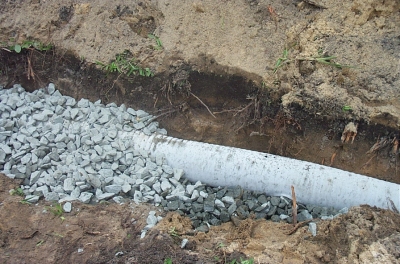French Drain Inspection
A French drain is a common means of diverting water from one location on a property to another in order to divert excess rainwater or to dry up soil that is excessively waterlogged,  such as land that is located near wetlands. Inspecting French drains is not within the scope of InterNACHI’s Residential Standards of Practice because they are typically located underground and not visible. However, inspectors may want to know more about this method of preventing flooding on a property because French drains may fail and subsequently cause visible signs of flooding at the exterior of a home’s property and potential moisture intrusion problems that affect the home itself.
such as land that is located near wetlands. Inspecting French drains is not within the scope of InterNACHI’s Residential Standards of Practice because they are typically located underground and not visible. However, inspectors may want to know more about this method of preventing flooding on a property because French drains may fail and subsequently cause visible signs of flooding at the exterior of a home’s property and potential moisture intrusion problems that affect the home itself.
What is a French Drain?
- Septic drainfields are designed to receive wastewater from a home's septic system. However, because they are not covered or protected from the elements, they tend to absorb water from sources other than the septic system. If a drainfield becomes over-saturated from excess stormwater (in addition to its normal load from the septic system), it may overflow and cause flooding at the property, which may back into the home. That's why the location for its installation is important. Swales and French drains are better and more specifically suited to divert excess rainwater.
- Swales are shallow ditches used to capture and divert rainwater. Unlike French drains, they do not contain piping to carry the diverted water. They are typically located along the property's boundary following a natural grade, as recommended by the U.S. Environmental Protection Agency (EPA), and rely primarily on existing topography for their required natural slope. Swales are commonly vegetated to promote the filtering of water and to encourage it to soak slowly back into the ground. According to the EPA, swales are impractical in areas that are commonly wet or have poorly draining soil, and may erode during peak flows.
- French drains are a swifter alternative than swales for diverting excess rainwater and are implemented to mitigate or prevent groundwater recharge and standing water. They are also appropriate for draining waterlogged soil. French drains can be located to provide proper draining where there is otherwise inadequate natural slope at the property.
Advantages of French Drains
- French drains are an extremely effective way to channel water away from a home to prevent water damage to the foundation and the interior of below-grade rooms. For this purpose, French drains are generally installed underground around the perimeter of a home’s foundation.
- Lawns that would otherwise be too moist can be transformed and rendered useful for gardens or children’s play areas.
- French drains are relatively inexpensive to install, particularly if they do not require excavation of existing exterior structures, such as walkways and decks.
- Installing a French drain does not necessarily require special tools.
- Installing a French drain may be dangerous if there are water, power or communications lines buried in the vicinity. Many states, such as Massachusetts and Maine, require that municipal authorities be notified prior to digging.
- Digging may disturb natural water flows and can cause affected water to pool.

- Installing a French drain may require that existing structures, such as decks and walkways, be removed, especially when using a backhoe to dig the trench.
- Weeping tile is prone to clogging over time, and may require expensive excavation to correct.
- French drains that become clogged may overflow without warning and cause damage, such as flooding in yards and basements.
- Existing structures may need to be removed if a French drain must be excavated.
- Exterior French drains that are installed without a sump pump rely on gravity to direct water flow. An adequate slope for gravity drainage may be difficult to establish for properties that are located at the bottom of a steep slope.

A French drain may be installed if there is a gravel pathway at the surface of a ditch. Inspectors may want to check:
- that the expelled water is not dispelled to a location that disturbs adjoining properties. Flooding disputes are a common cause of lawsuits among neighbors; and
- that dispelled water is not contaminated. Laws governing disposal of contaminated water differ by jurisdiction and local authorities should be consulted if diverted water may not meet lawful limits for contamination.
- the system may be clogged, and excavation for cleaning may be necessary;
- a fabric filter should be installed to help mitigate excess clogging of pipes;
- existing pipes may need to be replaced for wider ones if they are not large enough to handle demand;
- a slope of at least a 1% should be attained in systems that rely on gravity alone to move water; and
- an interior French drain system may be installed underground around the inside perimeter of the basement, if the basement remains flooded. For interior systems, a sump pump is typically required to force water away from the home. Only a qualified professional should perform this type of work.

